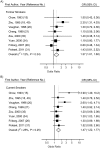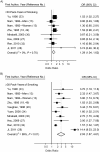Quantitative association of tobacco smoking with the risk of nasopharyngeal carcinoma: a comprehensive meta-analysis of studies conducted between 1979 and 2011
- PMID: 23785114
- PMCID: PMC3727336
- DOI: 10.1093/aje/kws479
Quantitative association of tobacco smoking with the risk of nasopharyngeal carcinoma: a comprehensive meta-analysis of studies conducted between 1979 and 2011
Abstract
Over the years, many studies have attempted to establish a link between tobacco smoking and an increased risk of nasopharyngeal carcinoma (NPC), but their results have been inconsistent. To clarify this link, we first conducted a comprehensive meta-analysis to integrate the findings of epidemiologic studies from the last half-century. The methodology used for this study followed the checklist proposed by the Meta-analysis of Observational Studies in Epidemiology (MOOSE) Group. Pooled risk estimates were generated using a random-effects model. Twenty-eight case-control studies and 4 cohort studies involving a total of 10,274 NPC cases and 415,266 comparison subjects were included. A substantial effect of smoking on the risk of NPC was identified in this study. The results showed that ever smokers had a 60% greater risk of developing the disease than never smokers (95% confidence interval: 1.38, 1.87); this was a robust dose-dependent association. More importantly, stronger associations were observed in low-risk populations and among persons with the predominant histological type of differentiated NPC than in high-risk populations and persons with an undifferentiated type; the odds ratios were 1.76 and 2.20, respectively, versus 1.29 and 1.27. In this comprehensive meta-analysis, well-established statistical evidence was provided about the role of tobacco smoking in the etiology of NPC.
Keywords: case-control studies; cohort studies; meta-analysis; nasopharyngeal carcinoma; odds ratio; tobacco smoking.
Figures






References
-
- Gallicchio L, Matanoski G, Tao XG, et al. Adulthood consumption of preserved and nonpreserved vegetables and the risk of nasopharyngeal carcinoma: a systematic review. Int J Cancer. 2006;119(5):1125–1135. - PubMed
-
- Blair A, Saracci R, Stewart PA, et al. Epidemiologic evidence on the relationship between formaldehyde exposure and cancer. Scand J Work Environ Health. 1990;16(6):381–393. - PubMed
-
- Partanen T. Formaldehyde exposure and respiratory cancer—a meta-analysis of the epidemiologic evidence. Scand J Work Environ Health. 1993;19(1):8–15. - PubMed
-
- Bosetti C, McLaughlin JK, Tarone RE, et al. Formaldehyde and cancer risk: a quantitative review of cohort studies through 2006. Ann Oncol. 2008;19(1):29–43. - PubMed
Publication types
MeSH terms
LinkOut - more resources
Full Text Sources
Other Literature Sources

